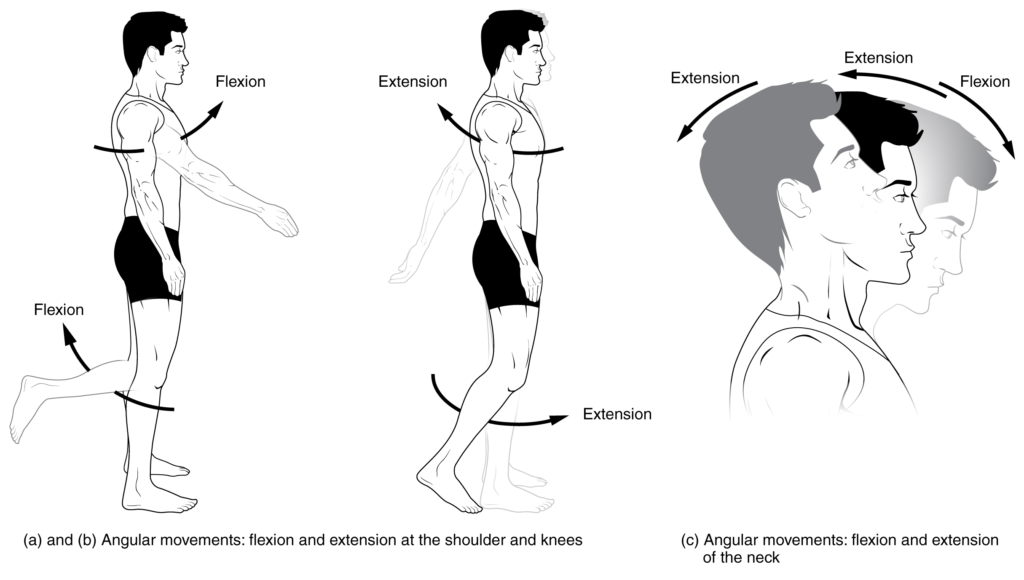Joint movements, also known as joint actions or articulations, refer to the various ways in which bones interact and move at the points where they meet. These movements are essential for a wide range of activities, from basic everyday tasks to complex athletic maneuvers. There are several types of joint movements, each with its own unique characteristics and examples of articulating joints. Here’s a detailed note on the types of joint movements and their articulations:
1. Flexion
Description: Flexion is a movement that decreases the angle between two bones, typically bringing them closer together. It occurs along the sagittal plane and is commonly associated with bending.
Examples of Articulating Joints:
Elbow joint (ulna and humerus during forearm flexion).
knee joint (flexing the lower leg toward the thigh).
hip joint (raising the thigh toward the abdomen).
2. Extension:
Description: Extension is the opposite of flexion. It increases the angle between two bones, typically straightening or unbending them.
Examples of Articulating Joints:
– Elbow joint (ulna and humerus during forearm extension).
– Knee joint (straightening the lower leg from a bent position).
– Hip joint (returning the thigh from a flexed position to the anatomical position).

3. Abduction:
Description: Abduction is the movement of a bone away from the midline of the body or another reference point. It occurs along the frontal plane.
Examples of Articulating Joints:
shoulder joint (raising the arm away from the side of the body).
hip joint (lifting the thigh away from the midline of the body).

4. Adduction:
Description: Adduction is the opposite of abduction. It is the movement of a bone toward the midline or another reference point.
Examples of Articulating Joints:
shoulder joint (lowering the arm back to the side of the body).
hip joint (returning the thigh to the midline of the body).
5. Rotation:
Description: Rotation involves the bone pivoting around its longitudinal axis. It can be either internal (medial) or external (lateral) rotation, depending on the direction of the turn.
Examples of Articulating Joints:
atlantoaxial joint (between the atlas and axis in the neck for head rotation).
hip joint (twisting the thigh inward or outward).

6. Circumduction:
Description: Circumduction is a combination of movements that results in a cone-shaped motion. It involves flexion, abduction, extension, and adduction in sequence.
Examples of Articulating Joints:
– Shoulder joint (swinging the arm in a circular motion).
– Hip joint (moving the thigh in a circular pattern).
7. Supination and Pronation:
Description: These movements refer to the rotation of the forearm around its longitudinal axis.
Supination: Turning the palm upward or forward.
Pronation: Turning the palm downward or backward.
Examples of Articulating Joints:
Radioulnar joint (between the radius and ulna during forearm rotation).
8. Dorsiflexion and Plantarflexion:
Description: These movements occur at the ankle joint.
Dorsiflexion: flexing the foot upward, bringing the toes closer to the shin.
Plantarflexion: Pointing the foot downward, pointing the toes away from the shin.
9. Elevation and Depression:
Description: These movements refer to the upward and downward movements of body parts, respectively.
Elevation: raising a body part, such as the shoulders, during a shrug.
Depression: lowering a body part, such as the mandible, during the opening of the mouth.
10. Protraction and Retraction:
Description: These movements involve the forward and backward movements of body parts, respectively.
Protraction: Moving a body part forward, such as jutting the jaw forward.
Retraction: moving a body part backward, such as pulling the shoulders back.
Understanding these types of joint movements and their articulations is crucial in anatomy, kinesiology, physical therapy, and sports science, as it helps in assessing range of motion, diagnosing joint conditions, and designing exercise and rehabilitation programs. These movements are essential for normal bodily functions and activities of daily living.
